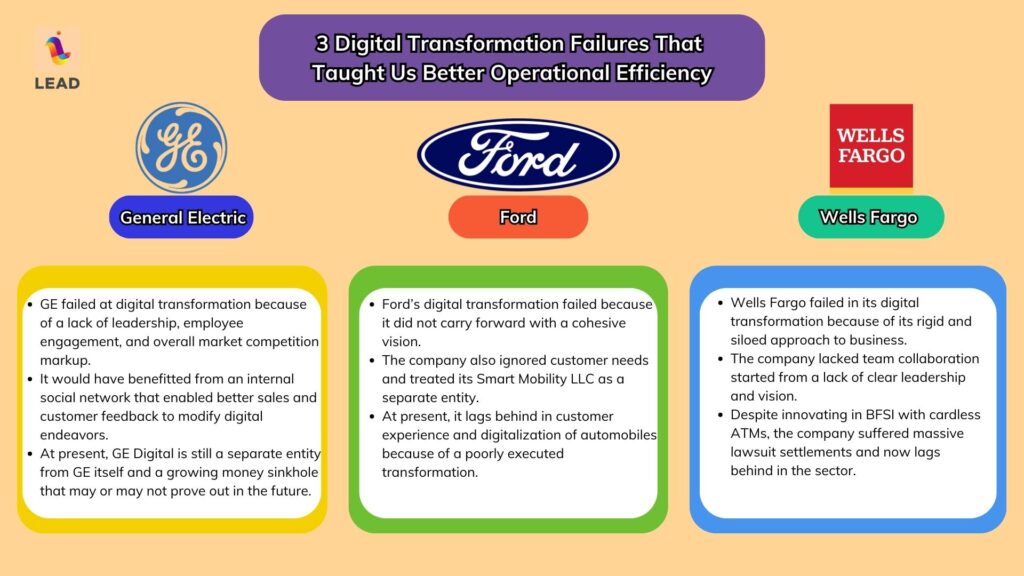Digital transformations are notoriously hard to pull off. Ask any CEO and they will probably be chock full of info on the pitfalls they have personally seen or heard of when it comes to this topic. And it’s not as if there is anyone too big to fail at this. In fact, there have been some major blunders in digital transformation campaigns in recent years that have changed the landscape of industries entirely.
At LEAD bot, we love looking into how businesses pursue their goals – from survival to success, and where they come up short. Previously, we wrote about things like leveraging employee engagement to make business transformation success, making a successful return-to-office bid, and developing workplace psychological safety better collaboration, and performance.
That is why we wanted to look at some of the most prominent digital transformation failures in recent memory and what they taught the world. We will also look at how companies can enhance their success ratio and business performance gain from all digital transformation campaigns. Let’s start:
3 Digital Transformation Failures That Taught Us Better Operational Efficiency
General Electric
Key Takeaways:
-
GE failed at digital transformation because of a lack of leadership, employee engagement, and overall market competition markup.
-
It would have benefitted from an internal social network that enabled better sales and customer feedback to modify digital endeavors.
-
At present, GE Digital is still a separate entity from GE itself and a growing money sinkhole that may or may not prove out in the future.
GE’s failure at digital transformation is arguably one of the most well-known instances of a large company botching up its transformation campaign. Among the most widely cited reasons for its failure were the lack of cohesive vision and communication and failure in collaboration at all levels. Further, GE also hyped up its impending transformation before it had seen its execution. This created expectations in the market which went unfulfilled when the transformation itself fell through.
As this WSJ article explains,
GE often spends years making sure every jet engine, locomotive, or MRI machine we manufacture is perfect—the equipment absolutely cannot fail. However, introducing software requires a completely different mentality. A new operating system like Predix is consistently going to iterate. The introduction of software—and everything that goes into a new digital product launch—is a culture shift for a company that historically uses Six Sigma (a highly disciplined product development process). This requires a new vocabulary and mindset—we call it “FastWorks.” It’s a process as well as a mindset to drive speed, simplicity, adaptability, and a focus on customer outcomes.
To expand this further, we take a quote from this Ivey case study which says, “I think the whole issue of digital transformation is incompletely understood by a lot of practicing managers.” We understand that GE had a major regime change during the transformation and this exacerbated its transformation execution woes. Further, with a lack of market understanding and a cohesion process fostered by employee engagement, it failed to meet its digital transformation goals. Finally, it had to resort to making GE Digital a separate entity from GE itself although the former is owned by the latter.
How Can LEAD bot help in such cases?
The divide between leadership, management, and employees spilled onto suppliers and collaborators during GE’s digital transformation journey. They needed a digital collaboration tool that could create interactions between silos so employees could figure out emergent problems without needing to wait for leadership to answer. Studies have shown that employee engagement leads to better productivity and employee retention and GE sorely missed insights and expertise at the middle management level. This may have saved GE a lot of time and money and also brought up changemakers who may have executed the entire digital transformation strategy better.

3 Digital Transformation Failures That Taught Us Better Operational Efficiency
Ford
Key Takeaways:
-
Ford’s digital transformation failed because it did not carry forward with a cohesive vision.
-
The company also ignored customer needs and treated its Smart Mobility LLC as a separate entity.
-
At present, it lags behind in customer experience and digitalization of automobiles because of a poorly executed transformation.
Ford is one of the leading manufacturers of automobiles in the world. They have been at the forefront of American automobile manufacturing for a long time now., In 2016, the company decided to step into the digital market and make its automobile products more customer-centric and digitally smart. Unfortunately, this plan did not work too well for the automobile manufacturing giant and it led to one of the biggest failures in digital transformation to date. The Ford Smart Mobility LLC remains one of the biggest and digitally first but far-from profitable investments made by an automobile manufacturer
Broadly speaking, the biggest reasons why Ford lost its battle for making a digital transformation change were as follows. Ford did not make its Smart Mobility process an inherent part of its business process and the LLC suffered because of it. It worked on a poor platform design and neglected the needs of its consumer base. This created a rift between what its consumer base wanted and how it wanted to work it’s newly established. Further, while Ford’s executive body recognized the need to invest in the digitalization of automobiles it failed to implement any noticeable changes and in fact, alienated its customers by ignoring their needs.
Meanwhile, this Google-sponsored study on Ford mentions the following,
“For so long, cars have really been isolated from the rest of people’s lives. We can change that by making them digital products,” Farley explains. To facilitate this shift, Ford has tapped into strategic partners like Google and is integrating software into its vehicles. Beginning in 2023, for example, millions of Ford and Lincoln models will be powered by the Android operating system, with Google apps and services built in.
So, Ford is bringing up its smart mobility car segment to measure up to industry leaders like Tesla or some Chinese brands. However, it is far away from actually getting there even though it could have got there already if it had played its digital transformation right.
How Can LEAD bot help in such cases?
Lead bot offers many knowledge sharing, employee engagement, and mentoring options that enable businesses to develop better integral values and strive towards better business prospects. In Ford’s digital transformation case, a better understanding of customer needs may have enabled its leadership to align better with its market. This customer feedback is essential but only possible with an internal social network that delivers the right market insights to create value for customers. If Ford had done the needful to pace its digital transformation the right way, then it may have created the kind of leverage it needed to gain momentum in the market with segment leaders like Tesla or other Chinese hybrid car manufacturers.

3 Digital Transformation Failures That Taught Us Better Operational Efficiency
Wells Fargo
Key Takeaways:
-
Wells Fargo failed in its digital transformation because of its rigid and siloed approach to business.
-
The company lacked team collaboration started from a lack of clear leadership and vision.
-
Despite innovating in BFSI with cardless ATMs, the company suffered massive lawsuit settlements and now lags behind in the sector.
Wells Fargo’s failed and now slowly rising digital transformation process is a major learning lesson for not just the BFSI market but also the entity economy. As a banking concern, it has been facing compliance issues for quite some time. In fact, Fargo has made several settlements over the past few years to keep its business going. And yet, the recent endeavor it made to implement digital transformation into its ongoing business did not yield a return.
Broadly speaking, the Wells Fargo digital transformation failure stems from its very rigidly structured operations. It makes sense for banking concerns to guard its operations but this did really hurt its digital transformation process. Further, it also suffered from a lack of clear leadership and vision which could then disperse down to middle management and drive transformation successfully.
As this study on Sage Pub explains,
Wells Fargo had to pay a fine of USD 185 million to various statutory agencies. The board used clawback provisions on the CEO and the head of the Community Bank. The latter was held responsible for the audacious sales culture which resulted in sales integrity issues. Wells Fargo seemed to have a perfect board, a lead director, and a much-acclaimed CEO, apart from seven board committees.
The combination of lack of cohesive activity, vision, and ability to bring talent together hurt its future prospects. Despite being an innovation pioneer in cardless ATMs, it fell behind and now does not enjoy the same level of prominence as it did before.
How Can LEAD bot help in such cases?
LEAD bot is designed to enable knowledge sharing along with fostering employee engagement activities. Further, it offers AI-supported mentoring and enables engagement activities that create the optimal kind of engagement for businesses. Both executives and managers can use the LEAD bot to create employee engagement ideas and activities that deliver greater integrative value and team collaboration.
So, when they pursue digital transformation, develop team efforts to implement changes and create lasting value development for the company. Just like in Wells Fargo, companies lose if they do not create knowledge-sharing internal social networks and sales support systems that enable advantaging from digital transformation.
Should You Invest in a Team Collaboration app like LEAD bot?
Digital transformation has many cogs behind it but the biggest among them is the people. Without a strong working team of talent individuals, no transformation process will succeed. Moreover, studies show that the best kind of transformation as well as operational efficiency increase manifests when teams have the capacity to work both interdependently and independently. This is only possible in businesses where people are encouraged to interact with each other outside of their departments and can create cross-team collaboration opportunities. This is where LEAD bot comes into the picture.
LEAD bot is a team engagement platform for big businesses and MNCs on Slack and Teams. It is an all-in-one team development software with features like virtual coffee chats, buddy programs, birthday celebrations & work anniversary celebrations, new hire onboarding programs, and Pulse Surveys.
LEAD bot also offers cutting-edge Organizational Network Analysis (ONA) for large-scale organizations. C-suite execs and mid-level managers benefit greatly in their decision-making from ONA and use its highly actionable insights for building strong connections across their workforce. This enables far more forward-leaning talent development and generates greater organizational interconnectedness! Foster better organizational health, talent development, employee retention, and overall performance with this simple app!
LEAD bot is a product of LEAD.app and we also LEAD.bot’s sister app Sunrize which showcases workplace attendance by graphs right on Slack! Book a demo now!







